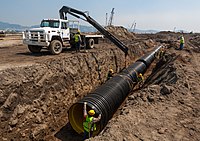
Photo from wikipedia
Abstract Recent research into transient reservoir response has developed a novel formulation of the diffusivity equation to model pressure, rate, and production, especially for unconventional reservoirs. This formulation characterizes the… Click to show full abstract
Abstract Recent research into transient reservoir response has developed a novel formulation of the diffusivity equation to model pressure, rate, and production, especially for unconventional reservoirs. This formulation characterizes the geometry of pressure propagation through a reservoir taking into account the heterogeneity of the reservoir and the boundary conditions which arise from multiple fractures and complex well completions. The formulation is derived from the asymptotic (high frequency) limit of the diffusivity equation for the impulse pressure solution. The formulation requires the solution of the Eikonal equation for the Diffusive Time of Flight (DToF) and the corresponding pore volume geometry contained within a Diffusive Time of Flight contour. Once the pore volume geometry is constructed, it may be used as the basis for either numerical or analytic solution. While numerical solutions are more general, the analytic approach is more readily applicable to production data analysis. The analytic approach may be used to determine two important field characteristics: the drainage volume of a well and the ratio of the produced volume to the drainage volume. In the pseudo steady state (PSS) limit, the latter would be the recovery factor for a reservoir. These quantities may be predicted from a model (for calibration purposes) or calculated directly from production data without resorting to any modeling. In this paper, we work directly with field production and pressure data to infer the drainage volume, and the instantaneous recovery ratio, defined as the ratio of the produced volume to the drainage volume. We also introduce a new w ( τ ) function that is related to a combined fracture and reservoir surface area. Our work draws upon the commonly used pressure transient and Rate Normalized Pressure (RNP) concepts. However, it specifically generalizes the concept of the drainage volume from PSS flow to transient flow, as is required for unconventional reservoirs, and then infers the underlying flow geometry to help differentiate and analyze different reservoir and fracture properties. The proposed formulation is applied to the analysis of the production data from shale oil reservoirs. The field data has been interpreted to describe the variations in performance characteristics seen in a number of wells.
Journal Title: Journal of Petroleum Science and Engineering
Year Published: 2017
Link to full text (if available)
Share on Social Media: Sign Up to like & get
recommendations!